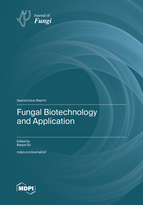Fungal Biotechnology and Application
A special issue of Journal of Fungi (ISSN 2309-608X).
Deadline for manuscript submissions: closed (31 December 2021) | Viewed by 50826
Special Issue Editor
Interests: phytochemicals; natural products; functional foods; human health
Special Issues, Collections and Topics in MDPI journals
Special Issue Information
Dear Colleagues,
This Special Issue is related to the “2020 International Conference on Biotechnology and Food Science (BFS 2020)” which will be held in Guangzhou, China, 18–20 December 2020.
BFS 2020 provides an enabling platform for innovative academics, engineers, and industrial experts in the field of biotechnology and food science to exchange new ideas and present research results.
Symposium participants, as well as all researchers working in the field, are cordially invited to contribute original research papers or reviews to this Special Issue of the Journal of Fungi.
Prof. Dr. Baojun Xu
Guest Editor
Manuscript Submission Information
Manuscripts should be submitted online at www.mdpi.com by registering and logging in to this website. Once you are registered, click here to go to the submission form. Manuscripts can be submitted until the deadline. All submissions that pass pre-check are peer-reviewed. Accepted papers will be published continuously in the journal (as soon as accepted) and will be listed together on the special issue website. Research articles, review articles as well as short communications are invited. For planned papers, a title and short abstract (about 100 words) can be sent to the Editorial Office for announcement on this website.
Submitted manuscripts should not have been published previously, nor be under consideration for publication elsewhere (except conference proceedings papers). All manuscripts are thoroughly refereed through a single-blind peer-review process. A guide for authors and other relevant information for submission of manuscripts is available on the Instructions for Authors page. Journal of Fungi is an international peer-reviewed open access monthly journal published by MDPI.
Please visit the Instructions for Authors page before submitting a manuscript. The Article Processing Charge (APC) for publication in this open access journal is 2600 CHF (Swiss Francs). Submitted papers should be well formatted and use good English. Authors may use MDPI's English editing service prior to publication or during author revisions.







